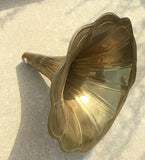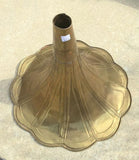Gramophone Phonograph Brass Horn Loudspeaker.
Gramophone Phonograph Brass Horn Loudspeaker.
History
In the beginning, was the famous American inventor Thomas Alva Edison (1847 – 1931) who invented the Phonograph, the machine for recording and reproducing any sound in 1877. During next years he improved it gradually and in 1878 launched his first phonograph, $10 for home common use. As a sound medium was usually wax cylinder with 2 or 4 minutes of recording. In 1896 he founded National Phonograph Company and sold his improved phonograph (which already had reliable spring motor and centrifugal governor of revs) Edison Home Phonograph $40 and model Standard $20. From 1912 Edison started with the production of gramophone discs under pressure of competitors. Sale and production of machines, phonograph cylinders and gramophone discs in Edison plants were definitely stopped in 1929 by economic depression.
However, the turn of the 19 and 20 century started superseded phonograph (in Europe it was a little bit earlier) more practical Gramophone, a machine for reproducing flat discs (records). Patent for it got the German inventor Emile Berliner (1851 – 1929) in 1887 already. In the beginning, he sold this machine as a toy. Gramophone discs had diameter 7 inches (17 cm) at first, later 10 inches (25 cm) or 12 inches (30 cm). Berliner was also co-proprietor. The Gramophone Company (Victor Company in America). It is one of the well-known gramophone companies in the world. Their trademark became in 1900 the picture from painter F. Barraud which represented a dog which hears the voice of his master from a gramophone horn.
The first type of machines the turntable was powered by hand through simply transmission and it was not any governor. In 1896 introduced his improved gramophone which had a spring motor and the centrifugal governor. The motor was winding not with a crank (it was a little bit later) but with lever movement side by side. From 1898 started with the production of gramophone companies all over the world. They were offered in wide variants from basic to luxury and parlour types or produced by a commission or for a specific event. The Gramophone was initially very expensive affair and could be bought by only a rich man. Therefore at the beginning of the 20th century, they offered as a coin machine for taverns, restaurants, hotels, cafes etc. After winding of motor by a crank and putting the right coin into a machine (it was set by the weight of coin) contrivance started functioning. These types of machines were offered by salesmen even for repayments at that time. The buyer paid repayments from profits of gramophone performance. The first types of gramophones had an internal amplifier–horn, which was made from various materials, miscellaneous versions and shapes. It made from metal (brass, copper, aluminium etc.), wood, glass, celluloid even paper. It was often painted by hand and was a work of art and decorated the room where the gramophone stood. On the other side, it was unhandy, heavy on space and sometimes hard for operating. Gramophones with internal (hidden) amplifiers were launched later (huge expansion between world wars). Mainly it was portable or a home cabinet. Volume control can be provided only by type (shape) of steel needle, from soft tone to extra loud tone. For each side of the record was used one point only. Therefore also needles were mass-produced in that period. Needles were sold in small tins (later paper or bakelite as well) packaging of 200 pieces usually. Today, these needle tins are sought after by collectors all over the world. In the beginning, the gramophone records were made only with one side record and from about 1908 made with a double-sided record. At the end of the 19th-century records had 100 (or more) revs per minute (rpm) but in about 1900 it was 80 respectively 78 rpm (the standard disc). The material used to make the records were shellac, but the producers tried to use also other materials mostly with bad results. Standard 78 rpm discs were made until the end of the '50s when production stopped, and also crank gramophones as well. Mechanical gramophones were superseded with much better electric record players and standard discs with the vinyl single (45 rpm) or LP (33 rpm) records and took the place of almost every modern household.
Item Code - REC17A126BAG
Width: 17 3/8" Height: 17 3/8" Depth: 14 1/2" Weight: 690 g









